Abstract
The objectives of this study were to (i) determine which of three simulated dosing regimens (gentamicin alone, simultaneous infusions of gentamicin and piperacillin, or staggered infusions of gentamicin and piperacillin) produced the fastest killing rate of Pseudomonas aeruginosa in serum, using the serum bactericidal rate (SBR) assay; and (ii) describe an alternative method of analysis of killing curves, the area under the killing curve (AUKC). Gentamicin alone or combined with piperacillin was added to heat-inactivated human serum to approximate drug concentrations achieved after the above-mentioned types of infusion. By a microdilution technique, seven strains of P. aeruginosa were exposed to no drug (control) and gentamicin alone or with piperacillin; colony counts were determined at hourly intervals for 5 h, and log10 CFU per milliliter was plotted versus time. Linear regression was used to calculate the slope (SBR) of each timed killing curve for each drug concentration tested alone or in combination. In addition, the AUKC for each curve was calculated. To compare simulated infusion regimens further, the cumulative AUKC (the sum of AUKCs for specific time points along the serum concentration-time curve for each simulated regimen) was calculated. With the SBR assay or AUKC determination, there was a significant increase in the rate of killing of all test strains by the combination compared with gentamicin alone only at gentamicin concentrations which exceeded the MIC (8, 5, and 2.5 micrograms/ml). Mean cumulative AUKC of the simultaneous-infusion regimen was significantly less (indicating faster killing) than either the staggered-infusion regimen or the gentamicin infusion alone. Both the SBR and AUKC have the potential for integration of in vitro microbiologic effects and in vivo pharmacokinetics of antimicrobial agents.
Full text
PDF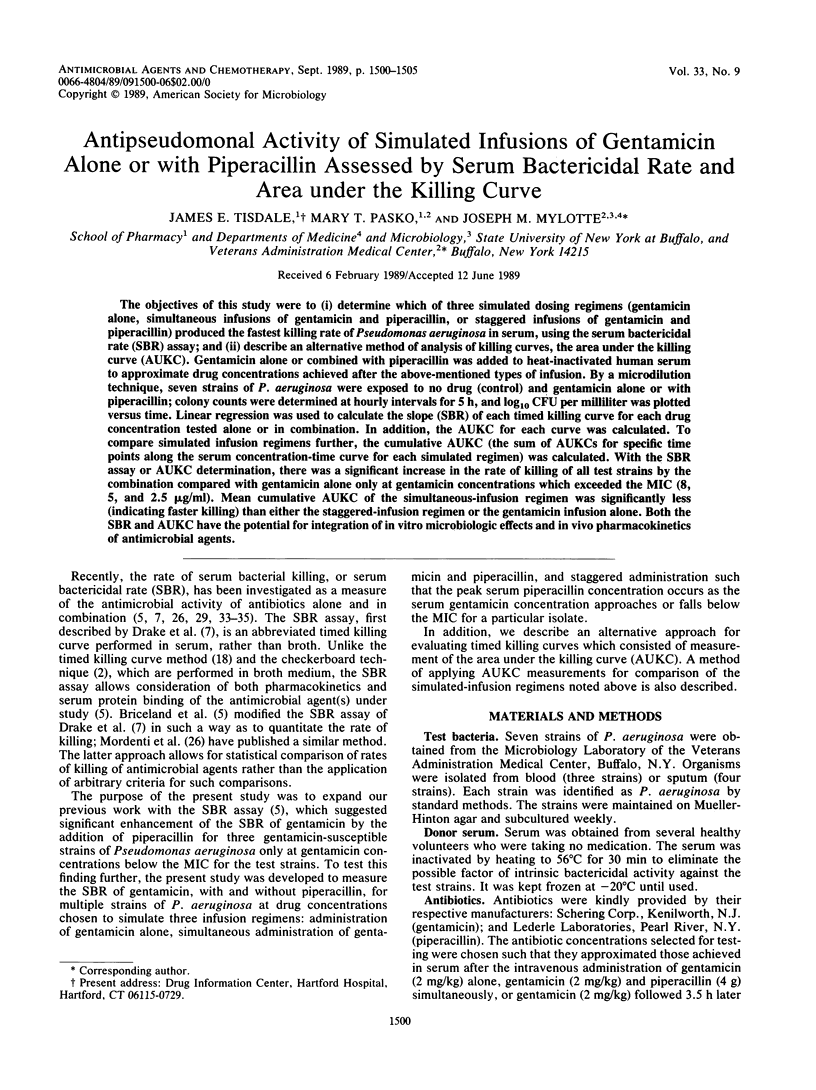
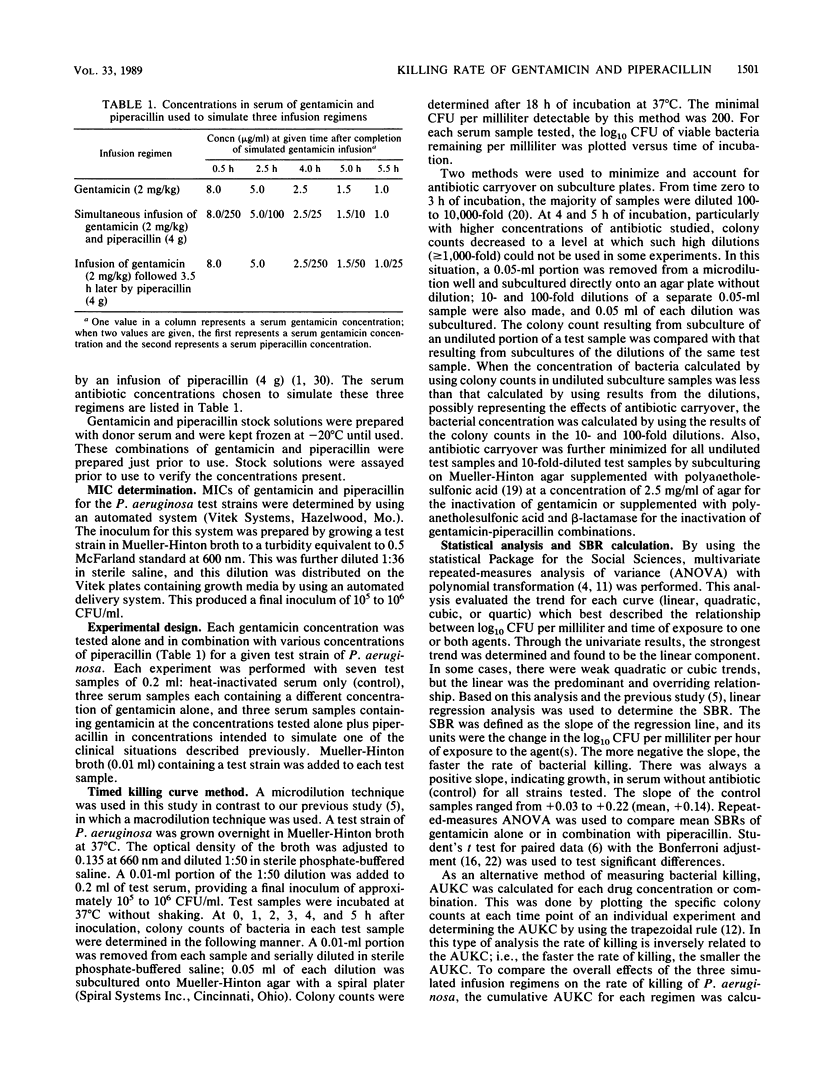
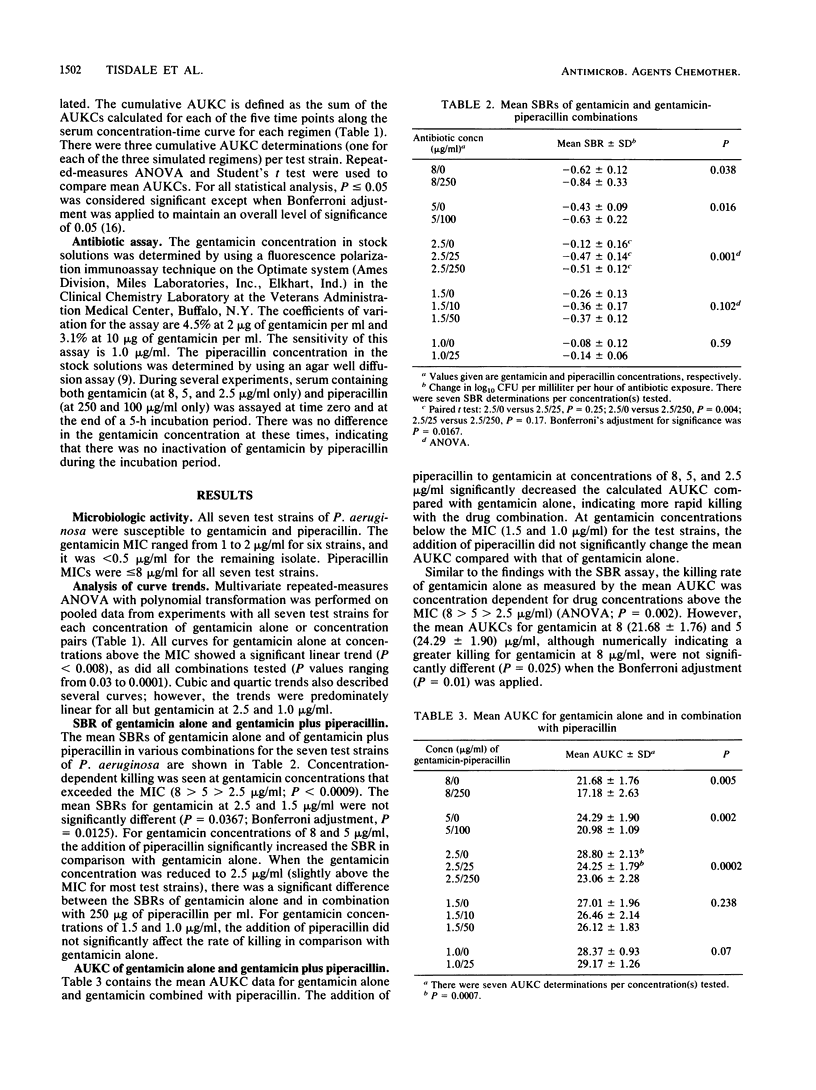
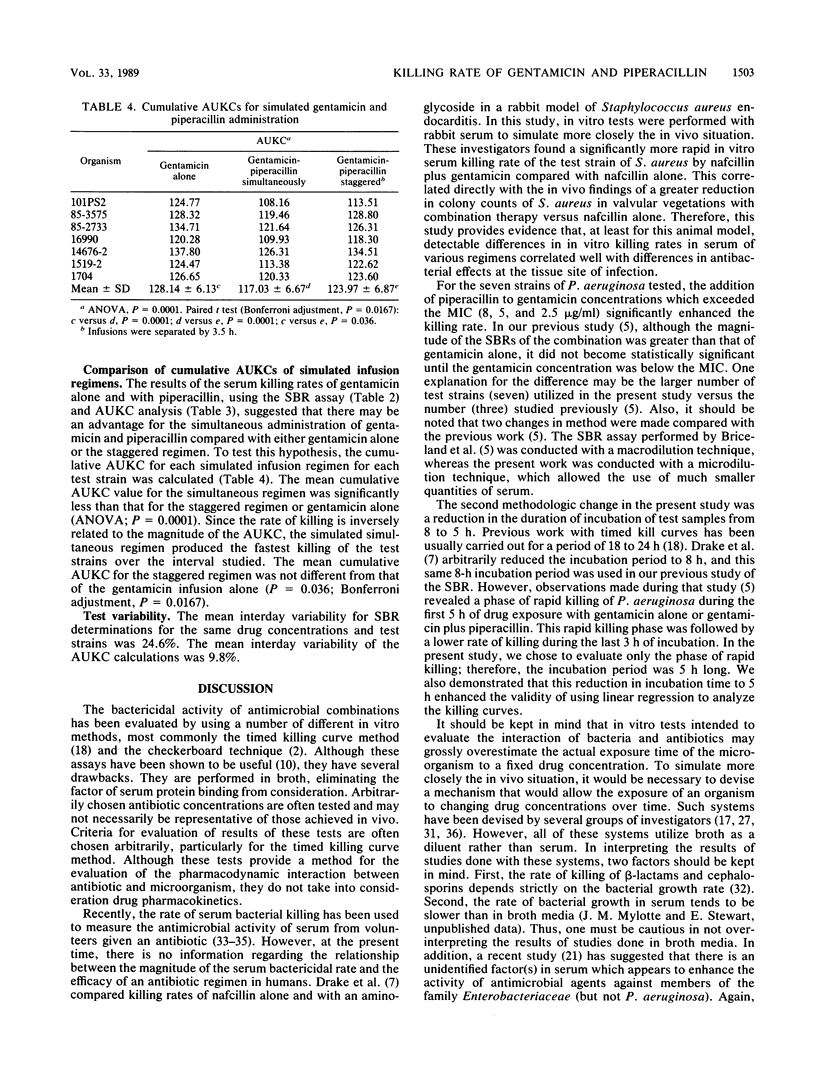
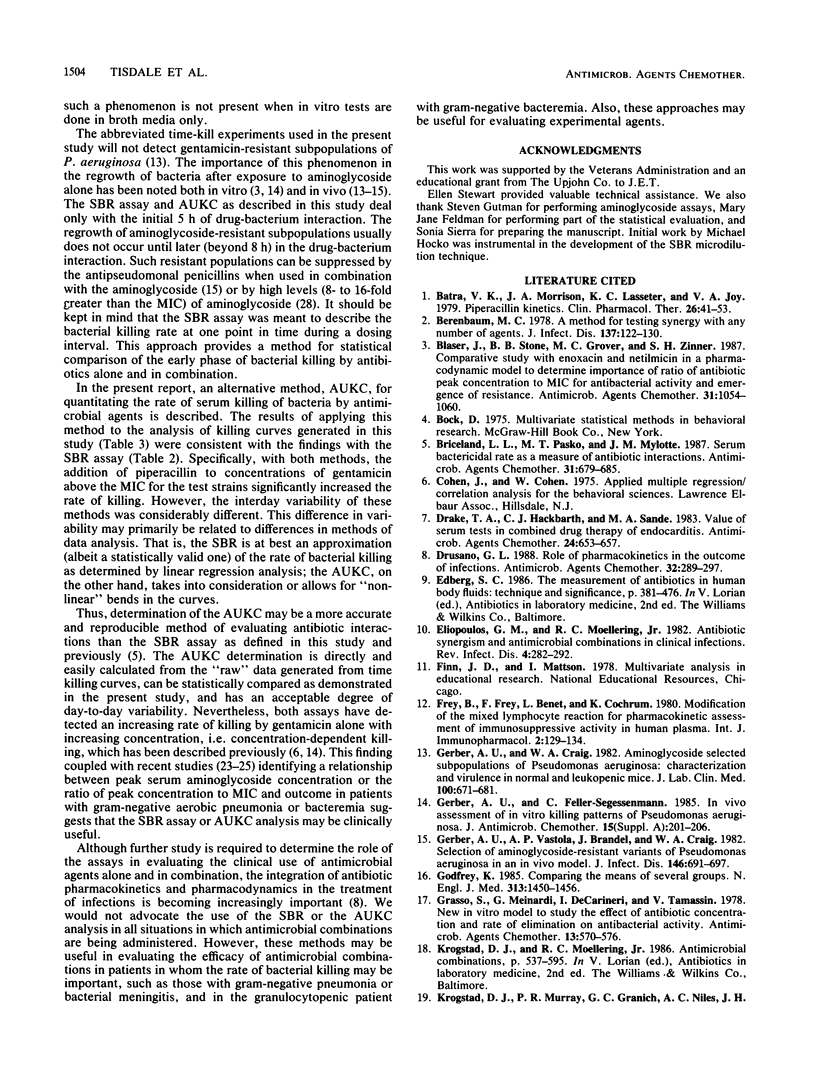
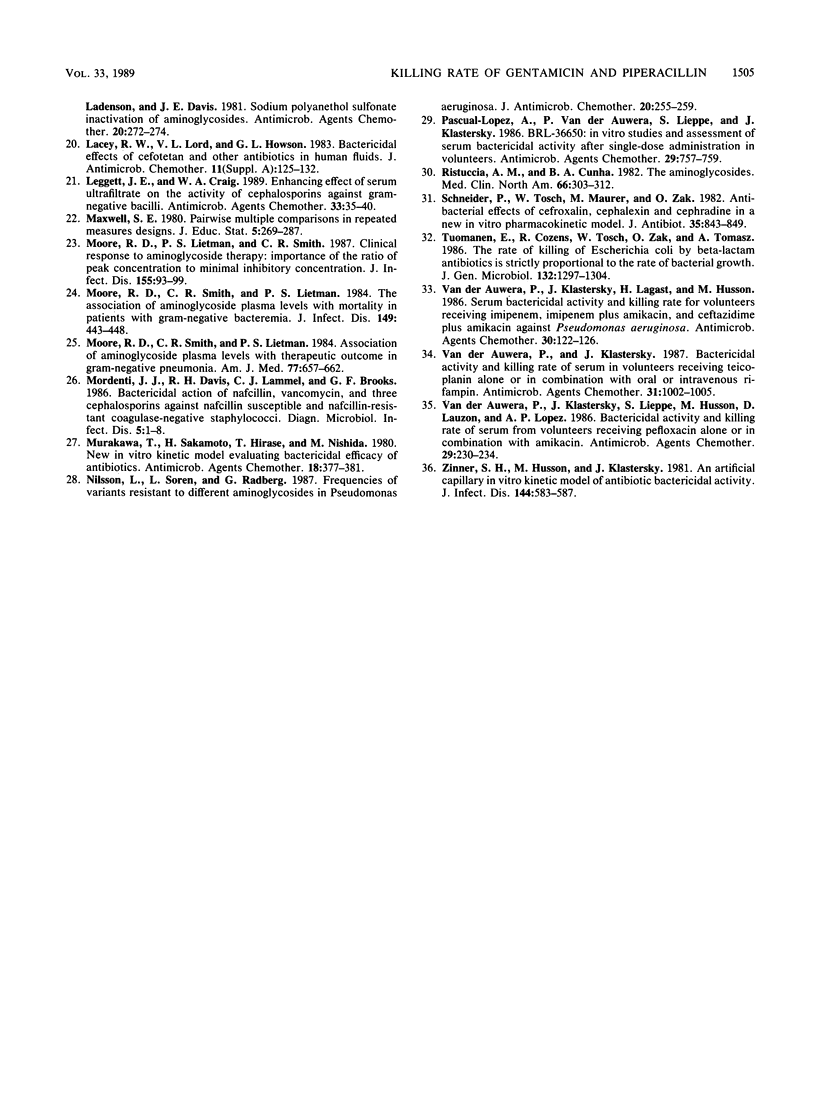
Selected References
These references are in PubMed. This may not be the complete list of references from this article.
- Batra V. K., Morrison J. A., Lasseter K. C., Joy V. A. Piperacillin kinetics. Clin Pharmacol Ther. 1979 Jul;26(1):41–53. doi: 10.1002/cpt197926141. [DOI] [PubMed] [Google Scholar]
- Berenbaum M. C. A method for testing for synergy with any number of agents. J Infect Dis. 1978 Feb;137(2):122–130. doi: 10.1093/infdis/137.2.122. [DOI] [PubMed] [Google Scholar]
- Blaser J., Stone B. B., Groner M. C., Zinner S. H. Comparative study with enoxacin and netilmicin in a pharmacodynamic model to determine importance of ratio of antibiotic peak concentration to MIC for bactericidal activity and emergence of resistance. Antimicrob Agents Chemother. 1987 Jul;31(7):1054–1060. doi: 10.1128/aac.31.7.1054. [DOI] [PMC free article] [PubMed] [Google Scholar]
- Briceland L. L., Pasko M. T., Mylotte J. M. Serum bactericidal rate as measure of antibiotic interactions. Antimicrob Agents Chemother. 1987 May;31(5):679–685. doi: 10.1128/aac.31.5.679. [DOI] [PMC free article] [PubMed] [Google Scholar]
- Drake T. A., Hackbarth C. J., Sande M. A. Value of serum tests in combined drug therapy of endocarditis. Antimicrob Agents Chemother. 1983 Nov;24(5):653–657. doi: 10.1128/aac.24.5.653. [DOI] [PMC free article] [PubMed] [Google Scholar]
- Drusano G. L. Role of pharmacokinetics in the outcome of infections. Antimicrob Agents Chemother. 1988 Mar;32(3):289–297. doi: 10.1128/aac.32.3.289. [DOI] [PMC free article] [PubMed] [Google Scholar]
- Eliopoulos G. M., Moellering R. C., Jr Antibiotic synergism and antimicrobial combinations in clinical infections. Rev Infect Dis. 1982 Mar-Apr;4(2):282–293. doi: 10.1093/clinids/4.2.282. [DOI] [PubMed] [Google Scholar]
- Gerber A. U., Craig W. A. Aminoglycoside-selected subpopulations of Pseudomonas aeruginosa: characterization and virulence in normal and leukopenic mice. J Lab Clin Med. 1982 Nov;100(5):671–681. [PubMed] [Google Scholar]
- Gerber A. U., Feller-Segessenmann C. In-vivo assessment of in-vitro killing patterns of Pseudomonas aeruginosa. J Antimicrob Chemother. 1985 Jan;15 (Suppl A):201–206. doi: 10.1093/jac/15.suppl_a.201. [DOI] [PubMed] [Google Scholar]
- Gerber A. U., Vastola A. P., Brandel J., Craig W. A. Selection of aminoglycoside-resistant variants of Pseudomonas aeruginosa in an in vivo model. J Infect Dis. 1982 Nov;146(5):691–697. doi: 10.1093/infdis/146.5.691. [DOI] [PubMed] [Google Scholar]
- Godfrey K. Statistics in practice. Comparing the means of several groups. N Engl J Med. 1985 Dec 5;313(23):1450–1456. doi: 10.1056/NEJM198512053132305. [DOI] [PubMed] [Google Scholar]
- Grasso S., Meinardi G., de Carneri I., Tamassia V. New in vitro model to study the effect of antibiotic concentration and rate of elimination on antibacterial activity. Antimicrob Agents Chemother. 1978 Apr;13(4):570–576. doi: 10.1128/aac.13.4.570. [DOI] [PMC free article] [PubMed] [Google Scholar]
- Krogstad D. J., Murray P. R., Granich G. G., Niles A. C., Ladenson J. H., Davis J. E. Sodium polyanethol sulfonate inactivation of aminoglycosides. Antimicrob Agents Chemother. 1981 Aug;20(2):272–274. doi: 10.1128/aac.20.2.272. [DOI] [PMC free article] [PubMed] [Google Scholar]
- Lacey R. W., Lord V. L., Howson G. L. Bactericidal effects of cefotetan and other antibiotics in human fluids. J Antimicrob Chemother. 1983 Jan;11 (Suppl):125–132. doi: 10.1093/jac/11.suppl_a.125. [DOI] [PubMed] [Google Scholar]
- Leggett J. E., Craig W. A. Enhancing effect of serum ultrafiltrate on the activity of cephalosporins against gram-negative bacilli. Antimicrob Agents Chemother. 1989 Jan;33(1):35–40. doi: 10.1128/aac.33.1.35. [DOI] [PMC free article] [PubMed] [Google Scholar]
- Moore R. D., Lietman P. S., Smith C. R. Clinical response to aminoglycoside therapy: importance of the ratio of peak concentration to minimal inhibitory concentration. J Infect Dis. 1987 Jan;155(1):93–99. doi: 10.1093/infdis/155.1.93. [DOI] [PubMed] [Google Scholar]
- Moore R. D., Smith C. R., Lietman P. S. Association of aminoglycoside plasma levels with therapeutic outcome in gram-negative pneumonia. Am J Med. 1984 Oct;77(4):657–662. doi: 10.1016/0002-9343(84)90358-9. [DOI] [PubMed] [Google Scholar]
- Moore R. D., Smith C. R., Lietman P. S. The association of aminoglycoside plasma levels with mortality in patients with gram-negative bacteremia. J Infect Dis. 1984 Mar;149(3):443–448. doi: 10.1093/infdis/149.3.443. [DOI] [PubMed] [Google Scholar]
- Mordenti J. J., Davis R. H., Lammel C. J., Brooks G. F. Bactericidal action of nafcillin, vancomycin, and three cephalosporins against nafcillin-susceptible and nafcillin-resistant coagulase-negative staphylococci. Diagn Microbiol Infect Dis. 1986 May;5(1):1–8. doi: 10.1016/0732-8893(86)90085-4. [DOI] [PubMed] [Google Scholar]
- Murakawa T., Sakamoto H., Hirose T., Nishida M. New in vitro kinetic model for evaluating bactericidal efficacy of antibiotics. Antimicrob Agents Chemother. 1980 Sep;18(3):377–381. doi: 10.1128/aac.18.3.377. [DOI] [PMC free article] [PubMed] [Google Scholar]
- Nilsson L., Sörén L., Rådberg G. Frequencies of variants resistant to different aminoglycosides in Pseudomonas aeruginosa. J Antimicrob Chemother. 1987 Aug;20(2):255–259. doi: 10.1093/jac/20.2.255. [DOI] [PubMed] [Google Scholar]
- Pascual-Lopez A., Van der Auwera P., Lieppe S., Klastersky J. BRL-36650: in vitro studies and assessment of serum bactericidal activity after single-dose administration in volunteers. Antimicrob Agents Chemother. 1986 May;29(5):757–759. doi: 10.1128/aac.29.5.757. [DOI] [PMC free article] [PubMed] [Google Scholar]
- Ristuccia A. M., Cunha B. A. The aminoglycosides. Med Clin North Am. 1982 Jan;66(1):303–312. doi: 10.1016/s0025-7125(16)31462-6. [DOI] [PubMed] [Google Scholar]
- Schneider P., Tosch W., Maurer M., Zak O. Antibacterial effects of cefroxadine, cephalexin and cephradine in a new in vitro pharmacokinetic model. J Antibiot (Tokyo) 1982 Jul;35(7):843–849. doi: 10.7164/antibiotics.35.843. [DOI] [PubMed] [Google Scholar]
- Tuomanen E., Cozens R., Tosch W., Zak O., Tomasz A. The rate of killing of Escherichia coli by beta-lactam antibiotics is strictly proportional to the rate of bacterial growth. J Gen Microbiol. 1986 May;132(5):1297–1304. doi: 10.1099/00221287-132-5-1297. [DOI] [PubMed] [Google Scholar]
- Van der Auwera P., Klastersky J. Bactericidal activity and killing rate of serum in volunteers receiving teicoplanin alone or in combination with oral or intravenous rifampin. Antimicrob Agents Chemother. 1987 Jul;31(7):1002–1005. doi: 10.1128/aac.31.7.1002. [DOI] [PMC free article] [PubMed] [Google Scholar]
- Van der Auwera P., Klastersky J., Lagast H., Husson M. Serum bactericidal activity and killing rate for volunteers receiving imipenem, imipenem plus amikacin, and ceftazidime plus amikacin against Pseudomonas aeruginosa. Antimicrob Agents Chemother. 1986 Jul;30(1):122–126. doi: 10.1128/aac.30.1.122. [DOI] [PMC free article] [PubMed] [Google Scholar]
- Van der Auwera P., Klastersky J., Lieppe S., Husson M., Lauzon D., Lopez A. P. Bactericidal activity and killing rate of serum from volunteers receiving pefloxacin alone or in combination with amikacin. Antimicrob Agents Chemother. 1986 Feb;29(2):230–234. doi: 10.1128/aac.29.2.230. [DOI] [PMC free article] [PubMed] [Google Scholar]
- Zinner S. H., Husson M., Klastersky J. An artificial capillary in vitro kinetic model of antibiotic bactericidal activity. J Infect Dis. 1981 Dec;144(6):583–587. doi: 10.1093/infdis/144.6.583. [DOI] [PubMed] [Google Scholar]


